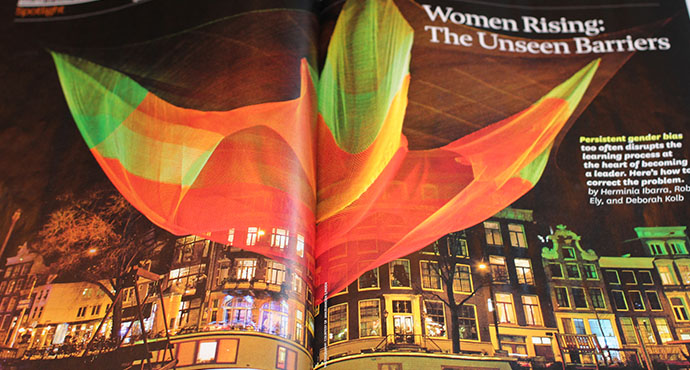The choice of Janet Echelman’s work to illustrate the Harvard Business Review article “Women Rising: The Unseen Barriers” opens up a much larger—and to me, more inspiring—debate about how women become true leaders.
Echelman’s work hints at the inner vision, that needs to happen for us to lead in any context. In this debate, rethinking the corporate workspace is no longer central; instead, it’s about freeing ourselves from traditional paths to seek out and pursue our own creative potential, guided by a grand vision.
In this context, Echelman’s personal story is revealing.
“Fourteen years ago, I searched for beauty in the traditional things, in craft forms,” Echelman said in her TED Talk. “Now I combine them with hi-tech materials and engineering to create voluptuous, billowing forms the scale of buildings. My artistic horizons continue to grow.”
The creative impulse that led Echelman to travel to India years ago, where she constructed a swelling, bulging self-portrait made of fishnet, wind and pure expression, would have been smothered in organizations like those the article describes. Despite high potential, her spirit likely would have been trained and mentored to death, and the world probably would never have seen “Wide Hips,” her pivotal early sculpture, and the more sophisticated successors that have made her famous.
When her vision grew to include enormous work that could withstand a hurricane, she grew to meet it. She concerned herself with the “what.” The “how” revealed itself over time, helped by focus and determination. She shed the comfort zone of the hand-tied knots she used to create her first fishnet wonder, instead building relationships with an industrial fishnet factory, studying their machines, and learning to make lace of extraordinary scale.
“There was no language to translate this ancient, idiosyncratic handcraft into something machine operators could produce,” Echelman said. “So we had to create one. Three years and two children later, we raised this 50,000-square-foot lace net. It was hard to believe that what I had imagined was now built, permanent and had lost nothing in translation.”
I propose that it’s the search for personal purpose—not business purpose—and the spark of grand imagination that can truly foster women’s leadership. Without a role model or “safe identity workspace” (whatever that is), Echleman created the conditions of her own success by first imagining them. Now it’s up to us to translate that lesson to our own circumstances.
Questions: What role does imagination play in your pursuit of success? Do you have a vision board or other illustration of your dreams? How do you keep your big dreams in mind as you navigate the nitty gritty of daily life?
Please scroll down to comment below. Thanks!


